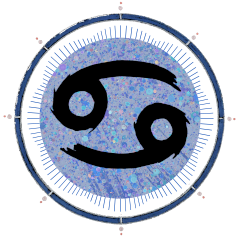Dear Friend and Reader:
It’s time for yet another visit with the chart for 12/21/12 before the event itself. Well, maybe ‘event’ is too strong of a word, though this seems to be the conclusion of a 5,125-year span of history that began on Aug. 11, 3113 BCE, day one of the first baktun of the Mayan long count.
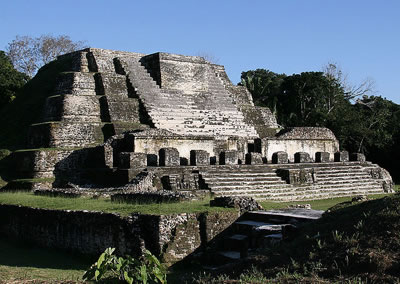
Long means pretty long. The big day concludes a span of 5,125.37 years, or exactly 1,872,000 days. On Friday, at the Capricorn solstice, the long count reaches day 13.0.0.0.0. This will conclude the passage of 13 baktuns, or phases of 144,000 days (each lasting about 394 years).
Is this the end of the Mayan calendar, or do we proceed into the 14th baktun (assuming, that is, that time continues at all)? That’s something of a mystery. Logic would say we move onto baktun 14, but the Mayans were in love with 13, which factors prominently into their spiritually oriented short-count calendar that is still used as a kind of ‘astrological’ reference today. The 5,125 year span of time indicated is one-fifth of a precessional cycle (that is, the full cycle of ‘astrological ages’). The long and short counts were among many calendars innovated by the Mayans, which also included a civil calendar. Unlike our calendars, theirs could handle long spans of time neatly and with precision.
They managed to land the ‘end date’ of the long count on the winter solstice, thousands of years in advance. That is pretty impressive, don’t you think? They were really into daykeeping, and they were good at it. And I am sure they would be impressed at all the fuss we are making today — or that anyone even knows or cares at this late date in history.
The Mayan long count is unique in that it vastly predates the coalescing of the civilization around 1800 BCE, and extends well past its (possibly very) sudden decline beginning around 800 to 900 CE. These are people who obviously took a long view of history, though those who created the calendar are not around to ask about their intent about whether there should be a 14th baktun. (For those curious about the technical aspects of the Mayan long count, see this article by Bruce Scofield.)
Considered the most advanced Mesoamerican civilization (meso meaning middle — it was located at the juncture of North and South America), the classical-era Mayans are known for their advanced writing, mathematics, architecture, urban life and long-distance trade. Eventually, they also suffered from political strife, warfare, corruption and the effects of climate change. Like us, they were humans living on Earth. No one theory explains the decline of the civilization, and aspects of it lasted well into the 17th century. [If you’re interested in the decline of classical Mayan civilization, here is an interesting Wikipedia article.]
Geographically, the civilization extended from what is now southern Mexico into Guatemala and Belize, and into northern El Salvador and Honduras. The Mayan people did not disappear; as their civilization declined, there was a diaspora, and their descendants still live throughout the region where the civilization existed, and far beyond.

Though there are no specific predictions, hints, clues or suggestions from Mayan culture that the world will ‘end’ a week from today, some people are on edge. There have been many predictions of the end of the world, and this is the latest among them, even though no such references exist from the culture that created the calendar. There is, however, the lurking feeling that maybe these mysterious old Mayan mathematician-shamans knew something that we did not.
Actually, we have a problem that they didn’t have, which is the belief in the Christian apocalypse — that is, the notion that our loving, compassionate God will destroy the world. This has been an obsession of the Christians since the beginning of their history. Their myth anthology ends with the Book of Revelation, featuring a protracted scene of devastation of the world, encrypted with all manner of mystical references, portents, forebodings and symbols — the Four Horsemen, the Seven Seals and the Scarlet Whore of Babylon (my date for next Friday night), to name a few.
Study of Revelation has given rise to such great literary works as The First Blast of the Trumpet Against the Monstruous Regiment of Women by John Knox, published in 1558. He was objecting to female sovereigns running countries and thus ruling over men (among them Queen Mary of England), reasoning, “For who can denie but it repugneth to nature, that the blind shal be appointed to leade and conduct such as do see?”
The Apocalypse in Your Undies
The word apocalypse means unveiling, as in the unveiling of the woman’s genitals on the wedding night. Translated into Christian terminology, it became understood as the gospel of God murdering everyone and calling their souls home. As Planet Waves contributor Astrodem commented this week, apocalyptic thinking “has a long and illustrious association with antisemitism, misogyny, racism, homophobia, fundamentalism, capitalism and imperialism.”
In other words, it’s not our friend. He continued, “Also, if apocalypse is fundamentally a sexual construct, then everything Wilhelm Reich said about suppressed sexuality and mystical longings fully applies. Think of our modern concept of apocalypse as a kind of mega anti-orgasm.”
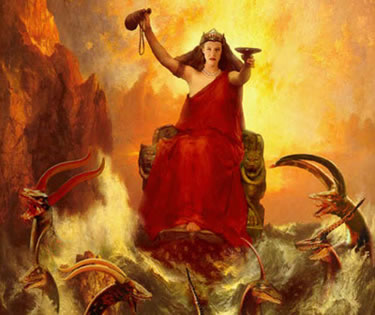
The reference to Reich is about the use of sexual repression to drive the individual emotional need for living under dictatorship. Reich demonstrated that the mystical longing created by suppressed orgasm is harvested by the political system and used against us. This is why the church and so many other political institutions preach a doctrine of abstinence from sex, which was a theme of Christianity from the earliest days (including trying to convince women to stop having sex with their husbands).
The notion of The End is so deeply encrypted into Western thinking that we have succeeded in developing the capacity to make it real, in the form of a world rigged with hydrogen bombs — that is, the apparatus of wargasm. We must note, however, that even the end of human civilization as we know it would not be The End. Even people who believe in The End know that; I was reading Prepper News the other night, and found the instructions for how to make a rabbit trap, just in case the supermarket isn’t open, or is out of hamburger. (“Most people fear the moment when disaster strikes and most people are not prepared for the moment it does,” its editors write. So you better stock up on on Bunny Helper.)
Some humans would survive even nuclear holocaust, along with “a republic of insects and grass,” in the words of Jonathan Schell in The Fate of the Earth, his appeal for nuclear disarmament. Life would go on, for those who survive — the name of the tune any day of any century on Earth.
The apocalypse is an idea, a fixation and most of all, a projection. It’s the result of something in consciousness, seen as an event in the world. Festering over the apocalypse is a cop-out. It would be a too-convenient way to get out of the problems we have created for ourselves on Earth, or have participated in creating, or have so far refused to help solve. And it’s a big waste of our potential, which of course is challenging to tap and develop.
As for the desire to solve those problems — I am listening carefully. I don’t hear much opposition to permanent war, nuclear power (a far more serious problem than nuclear bombs, because all we need is an earthquake, a power outage or solar flare to set things off) or fossil fuels. Hydraulic fracturing is gradually taking over the United States, extracting natural gas and contaminating our precious few freshwater aquifers with benzine and other vicious toxins. In many cities, the residents already drink their own piss, in the form of sewage recycled into tap water.
If I stretch my ears, I do hear some grumbling about genetically modified foods, though nothing in comparison to the problem. Fully one-third of American farmland has been cultivated with GMO crops, so we are at the point where genetic contamination is ubiquitous (that is, everywhere). These crops are often designed to withstand greater applications of pesticides, so they are more contaminated with weed and insect killers; some of them are, in themselves, registered insecticides that we eat for dinner.
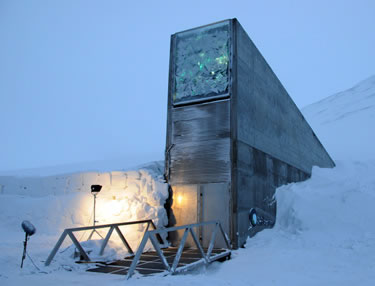
Meanwhile, we have no idea what is happening to the genotoxic waste being created by the process of developing these crops, which cannot be tested for by any watchdog group, since we don’t know what it is.
Fear of the apocalypse is related to the world ‘ending’ all at once (powered, whether we like the idea or not, by suppressed orgasm). What’s actually happening is a slow, painful decline of the biological integrity of the planet and its natural systems, including our bodies. Earlier this year I commemorated the 50th anniversary of Silent Spring by Rachel Carson, which was our first warning of things to come. Things have not gotten better since.
Dealing with these issues is overwhelming and inconvenient. There is plenty we can do to mitigate the damage personally, and to contribute to a longterm solution. Eating organic food (which is better for us, and helps organic farmers) is more expensive than eating from the processed food trough. This is particularly challenging for low- and middle-income people under the current economic strain. For those with more money, they might have to shift their priorities a little.
Most people are too busy working to survive, maintaining their lifestyles or entertaining themselves to death to have time to contribute to larger solutions. We do need to look carefully at how many of these circumstances are distractions from engaging the challenges at hand — which I would propose would likely lead to more fulfilling lives. In other words, I don’t think we’re happier for avoiding the problems we face, individually or collectively. I think that most of our pain, frustration and dysfunction are the result of trying to avoid them, and then encoutering the resulting depression and despair.
A Personal View of 12/21/12
Unlike most of my colleagues who have been discussing 2012, including various philosophers, futurists and literary speculators, I have taken a personal view on the topic. We don’t really understand what this date means in the Mayan context (except that from what I know, they celebrated the ends of eras) and they did not understand ours, since it didn’t yet exist.
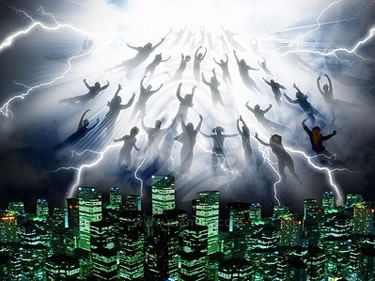
My own motto has been “2012 is up for grabs.” I have avoided both the end-time approach to change as well as the ‘everyone will become spontaneously enlightened’ approach (you know, the one about the shift into 5D). The spontaneous enlightenment perspective also denies the growth factor, as well as avoiding our need to address what’s holding us back. It’s similar to the Christian apocalypse in that it does not rely upon individual intent or cooperation. It’s the same thing, in that it’s involuntary and imposed upon us.
We can shift contexts from the Mayan date 13.0.0.0.0 to Dec. 21, 2012 by casting the Western astrology of that date and reading the chart. When we do, we see the prominence of many factors that were discovered by modern science starting in the 19th century. The one that stands out most boldly involves relationships. When the Sun arrives on the solstice point, there are two asteroids waiting for it there, (3) Juno and (81) Terpsichore. These help us call the tune of the chart.
Juno is considered a ‘major’ asteroid, the third of the big four that were first discovered between 1801 and 1807 — Ceres, Pallas, Juno and Vesta. It was named for Juno, the chief Roman goddess, who was the wife of Jupiter. In modern astrology, Juno is often associated with marriage, but also with jealousy and control (sometimes viewed as the patron saint of the cult of monogamy). I am aware of the debate over how Juno has been mischaracterized and slandered by mythology and our interpretation of it, though she is in fact a creature of mythology and its interpretation.
I’ve suggested that the Sun conjunct Juno in the first degree of Capricorn on 12/21/12 is about marrying ourselves before we try to marry someone else. The problem with this is that most of us would be marrying a bitch or a bastard. The lack of appeal is obvious. We present ourselves as nice people. Yet many, many peoples’ relationships with themselves are characterized by a seemingly endless litany of negative self-chatter, vicious self-critique and colored by various shades of ‘I wish I had’, ‘I wish I hadn’t’ and ‘I will eventually’.

We could say that it’s genetic, radioactive or toxic pollution that’s killing the Earth. We could say that it’s a corrupt political system, or the takeover of the planet by corporations. I propose that it’s our stressed-out, unforgiving relationships with ourselves. These in turn tie into all manner of family karma, which is typically full of all kinds of abuse.
This in turn results in the projection of our inner dynamics and the family system onto our partners and the whole society, as well as our obvious paralysis when it comes to doing something about whatever we perceive needs help.
In other words, do we not take action against GMO and nuclear power because we don’t have time — or is it because we’re too terrified to do so, fearing we’re going to be cast off? As for warfare, if we cannot get along with ourselves, how exactly can we get along with others? Note, Martha Lang-Wescott associates Juno with devotion to social justice causes, which checks out.
Juno’s Discovery Chart
For those who may be thinking that Juno has been given a raw deal in this discussion, let’s visit the discovery chart (that is, the astrology on the day that Juno was discovered) and see what we’re really looking at when we use this point. As I noted in a major feature on the minor planets in The Mountain Astrologer earlier this year, the discovery chart is a helpful tool for delineating a planetary discovery. The mythical figure and all its baggage is one thing; the chart is a more objective device. The discoverer, Karl L. Harding, did not know he was discovering Juno. He was discovering an object in space one night in September 1804.
Juno was discovered close to the Aries Point, retrograde at 3 degrees of Aries [see discovery charts here]. Its closeness to the Aries Point is reminding us that with Juno, we’re standing at an intersection of the individual and the collective — this emphasizes the significance of this point as an astrological factor with wide impact.
At the time, the cardinal points (which all have this personal/collective property) were loaded with planets in this chart, and these help us understand the meaning of the new discovery. For example, Juno in Aries is in a close square to Mars in Cancer, and opposite a Mercury-Saturn conjunction in Libra. Juno square Mars is angry. Juno opposed by Mercury and Saturn is that frustrated person encountering someone who wants to reason and compromise — that’s even more frustrating.
These aspects present a genuinely difficult situation. I am being polite when I say this; it feels infuriating. The fire of Aries is retrograde, that is, it’s internalized and struggles to express itself. The ruling planet of a sign that a new planet is discovered in tells us a lot about that planet. Being square the Aries ruler, Mars in Cancer, is about internalized emotionally based anger and frustration (involving pent-up feelings, desires and volition). Mars in Cancer can also be passionate, but in this chart, it’s trapped in a kind of construct that is difficult to escape.

Juno is in a conjunction to Vulkanus, a hypothetical planet that is about power. “If a sentence has the word mighty or powerful in it, the planetary signature will have Vulkanus in it,” Arlene Kramer writes of this point. So all of that frustrated retrograde Aries energy is subject to a case of megalomania — it can be very, very bossy, a known attribute of Juno. It’s also conjunct Quaoar, which is about family patterns and creation myths. This is part of a pattern of the family constellation. Whatever Juno is results from longterm family conditioning and has ‘always been that way’.
Juno is also in an opposition to Mercury and Saturn, which are in Libra. To Juno, this opposition feels like a limit on emoting, a fixed boundary wherein the rules are set by someone who is allegedly being too reasonable. The opposition is relational, but it’s also about projection. This is the sense of being inside a container when inside a relationship, and within that container, there are strict rules of what is appropriate and what is not. Saturn is the strongest planet in this chart, and it opposes Juno, or rather, Juno opposes Saturn. In this opposition, Juno meets not just his or her partner but an inner attribute that he/she does not like.
Just outside of that boundary is the asteroid Sappho (whose glyph is a double Venus). Sappho represents fellowship among people, and it also represents what Adrienne Rich described as the lesbian continuum, that is, the ways that women relate to one another that approximate intimate partnerships but take many other forms, some sexual, some not.
Relating on that continuum is outside the container of Saturn in this chart, suggesting that while inside the appropriateness construct of Mercury-Saturn, conditioned by the emotional frustrations of Mars in Cancer, there can be a real struggle to relate to others of the same sex in an intimate way. This goes in all directions. It’s an illustration of women mistrusting other women, and also of how same-sex friends can be as much of a perceived threat to an intimate partner as opposite sex friends can be. (In the discovery chart, Venus is in Leo on the South Node, describing a sense of entitlement, including the right to possess another person.)
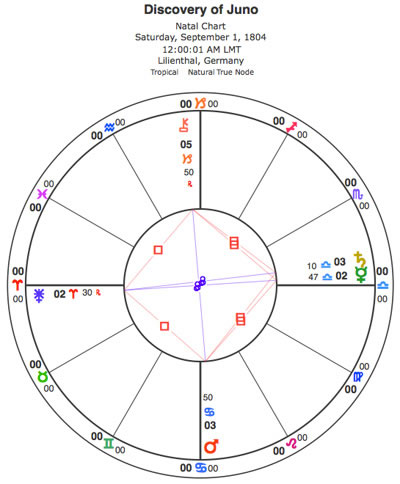
Finally, Juno is square Chiron, which is the fourth leg of a grand cross. There is healing in the picture, but really there is a sense of injury from the authoritarianism of Saturn and Capricorn. Chiron in this sign is in survivalist mode. This can be easily triggered by a diversity of factors, both personal and collective (since it stands at that intersection). We would do well to see where, exactly, that seemingly imposed authority is coming from.
Chiron is joined by two other points in Capricorn — Panacea and Icarus. The implication is that Juno seeks peak experiences of healing that will solve everything, i.e., if we go to couples counseling, everything will work out fine, or if I fix you, everything will be fine.
Chiron is opposite Mars. This is a clue how to work with Juno, which can include reverse psychology instead of trying to reason and compromise. Mars should say something to her like, “So I guess sex between you and me is out of the question?” This leaves an opening for her to say, “Maybe not! I’ll be the judge of that.” Note, if you are susceptible to reverse psychology, you probably have a mixed up relationship with yourself and are subject to manipulation.
To sum up, this thing called Juno, which astrologers think describes marriage and marriage relationships as we know them (and can represent both women and men), has a hard time expressing its most basic needs. Communication is a chore, even to the point of seeming impossible. Juno demands that tactics be used, instead of straightforward communication. There is constant emotional frustration, deeply engrained by the family constellation. Sound familiar? If we associate Juno with jealousy and control in relationships, we might go deeper and look at the rage and frustration that lurks beneath it, retrograde in Aries.
The message of this chart is: deal with the rage and frustration. Stop pretending it’s about someone else. Learn to communicate your feelings and your desires, and recognize that not doing so has consequences. When we can do this, then the more constructive attributes of Juno emerge, including a sane approach to relationships that is based on devotion rather than demands. But we all know how long it can take to get there, and we know that many of our relatives never did. So this is a full-scale transformation project if there ever was one.
As for The End of the World
Now, if we remember that all of this material is rolled up in a little ball, waiting for the Sun to arrive in the first degree of Capricorn on the fabled, mythologized day 12/21/12, we have some real information. Whether we take Juno as representing an inner relationship, or how our inner relationship extends into interpersonal relationships, we need to focus here.
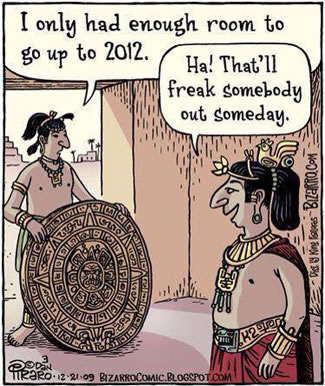
Now, what has this got to do with the end of the world?
Two things. In his article Jealousy and the Abyss, William Pennell Rock explains the relationship between the emotion of jealousy and the fear of death, or what he calls the abyss. Most people identify so closely with their relationships (or their desire for a relationship) that the notion of losing the connection comes with the feeling of imminent doom. Said another way, the sensation that the relationship might end is the same as the feeling that life will end, or one’s ego will die.
This is not just some spiritual theory — it’s a description of the actual sensation of jealousy, which is experienced as doomsday, with all of the elegance of the gag reflex. Jealousy is like a glove, and inside the glove is the hand of death, sticking its finger down your throat. In a sense, it’s a mockery of the fear of death, which is why we give it so much power.
Rock suggests that we embrace jealousy as our teacher. He’s saying that if a jealous episode is turned into a control drama, we are missing the opportunity to learn about ourselves, and to learn about the nature of love as surrender. When we turn love into control, we basically kill it, and part of ourselves along with it. This is the constellation of issues that we have on the agenda when it comes to learning about jealousy.
I would take Rock’s theory one step further, something that he doesn’t address in this article. I believe there is an erotic pull to what we think of as jealousy — that is, we can be passionate about embracing our lover as a whole person, with all their desires and feelings included. If we want to go beyond the gag/control reflex of jealousy, that’s the thing we have to do; it’s the only sane or loving response. It’s easier if we recognize this passion as an expression of legitimate sexual desire for, and embrace of, someone we love. This can be expressed many ways (monogamously or not), though the essence is embracing the beloved
as a whole person, complete with all their feelings, even the ones that might threaten you.
If we consider that this whole arrangement of feelings is described by Juno, we get a message from Terpsichore so directly involved in the solstice event — it’s the muse of dance. We have to move with this in order to address it. It’s not enough to stand still or be stuck.
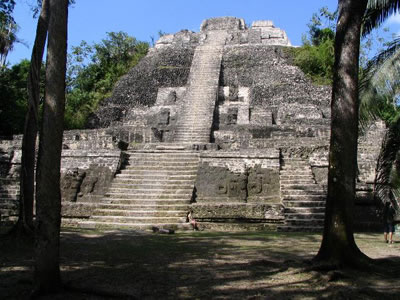
There’s one last connection to The End. In the solstice chart, asteroid Atlantis is on the Aries Point. It’s the earliest point in the whole zodiac that day. Atlantis, the myth of the ‘lost civilization’ — the one that killed itself due to its lack of ethics about its technology — is one of the most pervasive archetypes in our consciousness. That is to say, the planet representing our deepest collective fear of The End is sitting on the collective/individual intersection in the first degree of Aries, square Juno, Terpsichore and the Sun.
Our Juno crisis is speaking directly to our sensation of an impending apocalypse, and I believe, driving it forward. This suggests that the relationship crisis, and in particular our struggle with an inner relationship, is directly involved with our fears about the imminent demise of our society and our planet. This is an image of our obsession with do-or-die moments, imminent deadlines for enlightenment, the idea that ‘I must die married’, or the notion of the Wargasm at the End of Time: suicidal cultural narcissism.
When that doesn’t happen next week, we’ll still be faced with the same basic agenda for planetary healing, which starts with our emotions, and learning to be true to ourselves — and extends outward from there.
Lovingly,

Additional research: Tracy Delaney, Maggie Kelly, Alex Miller, Dale O’Brien and Bruce Scofield.



